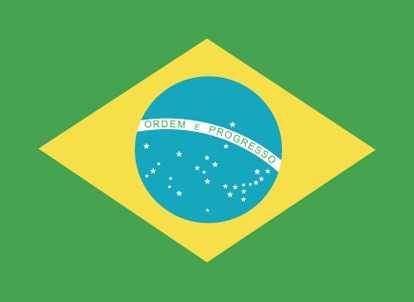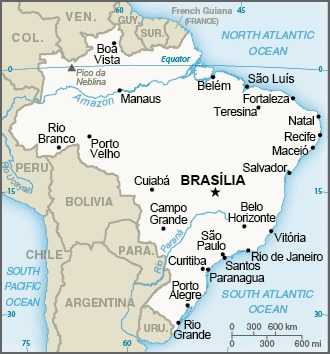Introduction
Background
After more than three centuries under Portuguese rule, Brazil gained its independence in 1822. By far the largest and most populous country in South America, Brazil underwent more than a half century of populist and military government until 1985, when the military regime peacefully ceded power to civilian rulers.
Geography
Area
total : 8,515,770 sq km
land: 8,358,140 sq km
water: 157,630 sq km
Climate
mostly tropical, but temperate in south
Natural resources
alumina, bauxite, beryllium, gold, iron ore, manganese, nickel, niobium, phosphates, platinum, tantalum, tin, rare earth elements, uranium, petroleum, hydropower, timber
People and Society
Population
total: 220,051,512
Ethnic groups
mixed 45.3%, White 43.5%, Black 10.2%, Indigenous 0.6%, Asian 0.4% (2022 est.)
Languages
Portuguese (official and most widely spoken language); note - less common languages include Spanish (border areas and schools), German, Italian, Japanese, English, and a large number of minor Amerindian languages
Religions
Roman Catholic 52.8%, Protestant 26.7% (Evangelical 25.5%, other Protestant 1.2%), African-American cultist/Umbanda 1.8%, other 3%, agnostic/atheist 0.6%, none 13.6%, unspecified 1.4% (2023 est.)
Population growth rate
0.61% (2024 est.)
Government
Government type
federal presidential republic
Capital
name: Brasília
Executive branch
chief of state: President Luiz Inácio LULA da Silva (since 1 January 2023)
head of government: President Luiz Inácio LULA da Silva (since 1 January 2023)
Legislative branch
description: bicameral National Congress or Congresso Nacional consists of:
Federal Senate or Senado Federal (81 seats; 3 members each from 26 states and 3 from the federal district directly elected in multi-seat constituencies by simple majority vote to serve 8-year terms, with one-third and two-thirds of the membership elected alternately every 4 years)
Chamber of Deputies or Camara dos Deputados (513 seats; members directly elected in multi-seat constituencies by open party-list proportional representation vote to serve 4-year terms)
Economy
Economic overview
industrial-led economic growth model; recovering from 2014-2016 recession when COVID-19 hit; industry limited by Amazon rainforest but increasing deforestation; new macroeconomic structural reforms; high income inequality; left UNASUR to join PROSUR
Real GDP (purchasing power parity)
$4.016 trillion (2023 est.)
$3.902 trillion (2022 est.)
$3.788 trillion (2021 est.)
Real GDP per capita
$18,600 (2023 est.)
$18,100 (2022 est.)
$17,700 (2021 est.)
Agricultural products
sugarcane, soybeans, maize, milk, cassava, oranges, chicken, rice, beef, wheat (2022)
Industries
textiles, shoes, chemicals, cement, lumber, iron ore, tin, steel, aircraft, motor vehicles and parts, other machinery and equipment
Exports
$389.626 billion (2023 est.)
$380.619 billion (2022 est.)
$315.494 billion (2021 est.)
Exports - partners
China 26%, US 11%, Argentina 5%, Netherlands 3%, Spain 3% (2022)
Exports - commodities
soybeans, crude petroleum, iron ore, refined petroleum, corn (2022)
Imports
$346.639 billion (2023 est.)
$376.084 billion (2022 est.)
$306.087 billion (2021 est.)
Imports - partners
China 24%, US 18%, Germany 5%, Argentina 5%, India 4% (2022)
Imports - commodities
refined petroleum, fertilizers, vehicle parts/accessories, crude petroleum, pesticides (2022)
Exchange rates
reals (BRL) per US dollar -
Page last updated: Wednesday, July 24, 2024




